Office of the State Comptroller - Nancy Wyman
2001 Comptroller's Report on
Connecticut's
Economic Health
The State's Financial Position
REPORTING FORMAT
The financial data presented below was developed in accordance with Generally Accepted Accounting Principles (GAAP).
GAAP is the standard for financial reporting in both the public
and private sectors. To date, Connecticut has not adopted GAAP
for budgetary appropriation and control purposes. The state
uses a modified cash accounting system as its legal budget
basis. However, due to volatility in the timing of payments and
posting of revenues, the modified cash system can distort the
state's true financial picture. GAAP reporting eliminates the
distortions and, therefore, provides a more accurate financial
overview of the state's fiscal position.
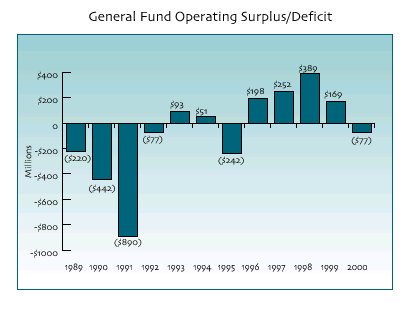
In Fiscal Year 2000, the state posted a net General Fund budget
surplus of $300.4 million on a modified cash basis; however,
on a GAAP basis the state recorded a General Fund deficit of
$77 million. Two factors explain the large difference in the
Fiscal Year 2000 General Fund modified cash basis and GAAP
numbers. First, $86.1 million in state financed Medicaid
expenditures incurred in Fiscal Year 2000 were not included in
the calculation of the Fiscal Year 2000 modified cash basis
surplus. Because these Medicaid payments were not processed
until Fiscal Year 2001, they were not counted as expenditures
under modified cash accounting. Thus, the surplus was
artificially inflated.
On a GAAP basis, the date on which the liability is incurred is
used without regard to when the actual payments are processed. Therefore, Fiscal Year 2000 Medicaid expenditures
were $86.1 million higher on a GAAP basis. Second, on a
modified cash basis, surplus revenues from prior years can be
brought forward to finance current spending. On a GAAP basis,
only revenues actually earned during the year can be used to
finance that year's spending.
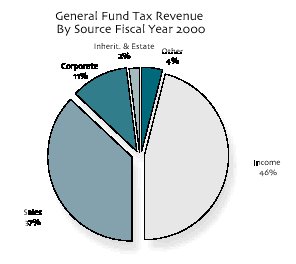
In Fiscal Year 2000, $290 million in spending was financed
from prior year revenues. Under GAAP, these expenditures must
be charged against revenue actually earned in Fiscal Year 2000,
thus reducing the surplus. A majority of the spending financed
from prior year revenues has been for one-time items. To the
extent that the expenditures financed from prior year revenues
are not recurring, a permanent GAAP imbalance between
revenues and expenditures is not created.
FISCAL YEAR 2000 GENERAL FUND PERFORMANCE - OPERATING RESULTS
FOR ONE STATE FUND IN A SINGLE FISCAL YEAR
- The General Fund is the state's largest single operating fund.
Over 85 percent of all state operating expenses are accounted
for within the General Fund.
- In Fiscal Year 2000, the state recorded a General Fund deficit
of $77 million with revenues totaling $12.336 billion and
expenditures of $12.413 billion. The deficit is equal to 0.6
percent of General Fund expenditures.
- Since the introduction of the income tax in 1991, the state's
cumulative General Fund surpluses total to $756 million.
- The sum of $34,960,241 was placed in the state's Rainy Day
Fund in Fiscal Year 2000 bringing the balance to $564,037,776.
In addition, $265,474,330 was made available
for school construction and rewiring to support information
technology in classrooms.
GENERAL FUND REVENUES:
- In Fiscal Year 2000, total General Fund revenue increased 7.7 percent over
the prior year. The income tax and the sales tax, which combine to produce
55.6 percent of the total revenue, increased by 12.1 percent and 5.5 percent
respectively from the previous year. Sizable revenue growth occurred despite
tax reductions approximating $300 million that were implemented in Fiscal
Year 2000.
- Taxes accounted for 67.1 percent of all General Fund revenue. Federal
payments to the state contributed 24.4 percent to total revenue. The
remaining 8.5 percent of General Fund revenues consisted of gaming payments,
interest earnings, licenses, fees, investment earnings, fines and
forfeitures, charges and other miscellaneous payments.
- Of the major General Fund revenue sources, the income tax has experienced
the highest rate of increase with five-year average annual compounded growth
of 10.4 percent. Strong employment gains coupled with booming financial
markets explain the increase.
| GENERAL FUND REVENUES (MILLIONS OF DOLLARS) |
|
FY95 |
FY96 |
FY97 |
FY98 |
FY99 |
FY00 |
FIVE-YEAR ANNUAL
COMPOUNDED
GROWTH RATE |
| Income |
2,306 |
2,606 |
2,799 |
3,197 |
3,368 |
3,777 |
10.4% |
| Sales |
2,355 |
2,444 |
2,598 |
2,759 |
2,922 |
3,082 |
5.5% |
| Corporation |
604 |
629 |
534 |
506 |
461 |
413 |
-7.3% |
| Public Utilities |
185 |
192 |
179 |
170 |
168 |
163 |
-2.5% |
| Inheritance & Estate |
183 |
231 |
208 |
259 |
216 |
200 |
1.8% |
| Insurance Companies |
171 |
167 |
189 |
183 |
180 |
187 |
1.8% |
| Tobacco |
130 |
125 |
126 |
126 |
122 |
121 |
-1.4% |
| Other Taxes |
416 |
437 |
421 |
385 |
362 |
340 |
-4.0% |
| TOTAL TAXES
|
6,350 |
6,831 |
7,054 |
7,585 |
7,799 |
8,283 |
5.5% |
|
|
|
|
|
|
|
|
|
OTHER REVENUE
|
|
|
|
|
|
|
|
| Federal Grants |
2,562 |
2,644 |
2,585 |
2,646 |
2,709 |
3,005 |
3.2% |
| Casino Payments |
136 |
149 |
204 |
258 |
288 |
319 |
18.6% |
| Lottery |
250 |
262 |
252 |
267 |
274 |
254 |
0.3% |
| Miscellaneous |
346 |
333 |
370 |
356 |
387 |
475 |
6.5% |
|
TOTAL REVENUE
|
9,644 |
10,219 |
10,465 |
11,112 |
11,457 |
12,336 |
5.0% |
GENERAL FUND EXPENDITURES:
- In Fiscal Year 2000, General Fund spending increased by 10 percent, almost
triple the general rate of inflation. This approximates the historically
high spending levels of the early part of the last decade.
- For the third straight year the state's constitutional cap on spending
was exceeded. The additional appropriations required a declaration of
extraordinary circumstances by the Governor. The cap was exceeded by $232.8
million in Fiscal Year 2000. Over the last three years, the spending cap has
been lifted to permit additional spending totaling $952.5 million.
- The Fiscal Year 2000 expenditure growth rate is more than five percentage
points higher than the average annual compounded growth over the past five
years. The spending trend is moving in the wrong direction.
| GENERAL FUND EXPENDITURES (MILLIONS OF DOLLARS) |
| FIVE-YEAR ANNUAL |
|
|
|
|
|
|
|
|
FY95 |
FY96 |
FY97 |
FY98 |
FY99 |
FY00 |
COMPOUNDED
GROWTH RATE |
| Legislative |
47 |
48 |
52 |
55 |
65 |
69 |
8.0% |
| General Government |
510 |
550 |
554 |
600 |
845 |
815 |
9.8% |
| Regulation & Protection |
103 |
105 |
116 |
121 |
215 |
255 |
19.9% |
| Conservation and Development |
64 |
65 |
80 |
81 |
92 |
99 |
9.1% |
| Health & Hospitals |
781 |
819 |
893 |
952 |
1,050 |
1,146 |
8.0% |
| Human Services |
3,378 |
3,439 |
3,496 |
3,541 |
3,475 |
3,770 |
2.2% |
| Education |
1,725 |
1,820 |
1,805 |
1,879 |
1,952 |
2,065 |
3.7% |
| Higher Education |
450 |
442 |
482 |
517 |
588 |
698 |
9.2% |
| Corrections |
789 |
839 |
943 |
932 |
1,027 |
1,153 |
7.9% |
| Judicial |
234 |
265 |
290 |
311 |
352 |
399 |
11.3% |
| Federal & Other Grants |
871 |
808 |
607 |
682 |
551 |
713 |
-3.9% |
| Debt Service |
845 |
729 |
805 |
864 |
973 |
1,037 |
4.2% |
| Other |
89 |
92 |
90 |
188 |
103 |
194 |
16.9% |
|
TOTAL
|
9,886 |
10,021 |
10,213 |
10,723 |
11,288 |
12,413 |
4.7% |
| Note: Human Services includes Medicaid expenditures. The decrease in Federal & Other Grants is largely due to an
accounting correction n the treatment of disproportionate share payments not a reduction in
federal money. |
BEYOND THE GENERAL FUND - TOTAL GOVERNMENTAL OPERATIONS
The state undertakes various activities that do not appear in the General
Fund. These activities include transportation and housing programs, grants to
municipalities, loan programs and other services. When these activities are
combined with those of the General Fund, a true picture of state governmental
operations emerges.
- Combined governmental operating results for Fiscal Year 2000 show a
deficit of $615 million.
- Operating deficits of $593 million were incurred in the grants and loan
programs and housing programs. The shortfalls must be covered through debt
financing. Issuing bonds to cover annual grants, loans and housing programs
that have become a part of ongoing state operations is a dubious financial
practice.
CUMULATIVE FINANCIAL POSITION OF THE STATE- THE BALANCE SHEET
- In evaluating the state's fiscal health, there is a tendency to focus
exclusively on a single year of state operations. This approach fails to
provide an overall, long-term view of the state's financial position. The
balance sheet provides this overall perspective. The balance sheet shows
state assets, liabilities, and fund balances at the close of each fiscal
year.
- At the end of Fiscal Year 2000, the General Fund balance sheet displayed a
cumulative GAAP deficit of $675 million. This represents a 12 percent
increase over the previous year.
- The main reason for the balance sheet deficit is the state's continued
reliance on an unusual system of budgeting. The state's modified cash
accounting system that is used for budgeting purposes allows some revenues
to be counted before they are earned while some expenditures are not counted
for months after the liability arises. When GAAP corrections are made a
deficit results.
- The GAAP deficit is an important number because those who invest in
Connecticut's bonds and notes review it. If the state's GAAP deficit is
perceived to present investment risk, the interest payments on the debt will
rise costing state taxpayers millions of dollars more.
- The way to improve the state's balance sheet position is clear: adopt
GAAP as the legal basis for state budgeting.
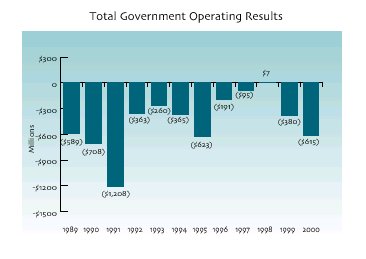
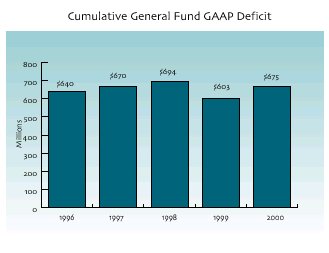
DEBT POSITION
- Connecticut continues to lead the nation in state tax supported debt per
capita. Bonded debt per capita has more than doubled over the past decade
growing to $2,863 by the end of Fiscal Year 2000.
- In Fiscal Year 2000, the state added an additional $397 million to its net
outstanding bonded debt total. To see growing debt burdens in these
prosperous times is of great concern.
- In Fiscal Year 2000, the state issued $1.126 billion in new debt. Of this
total $489 million was for infrastructure or other assets benefiting future
generations of taxpayers. The remaining $637 million was used to fund
on-going state operating expenses. Bonding
used to provide tangible benefits to future generations is justifiable;
bonding for ongoing programs that could be considered part of normal
government operating expenses is not sound fiscal policy.
- Large amounts of debt require high annual debt service (principal and
interest) payments. In Fiscal Year 2000, debt service payments consumed
about nine cents of every dollar spent by the state.
- Debt service is a fixed cost that cannot be quickly adjusted when state
revenue growth slows and budget deficits areprojected. In difficult economic
times a high debt load can cripple a state's ability to respond
effectively to the fiscal challenges it faces.
- Bonded debt represents about half of the state's total long-term
obligations. In Fiscal Year 2000, state long-term debt obligations totaled
$18.002 billion, an increase of $798 million or 4.6 percent over the
previous year. Bond debt and unfunded pension liabilities account for 96.5
percent of the total long-term obligations.
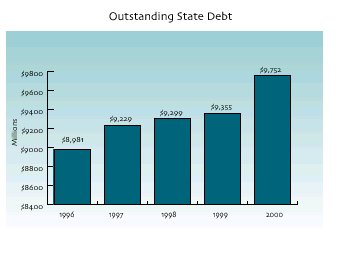
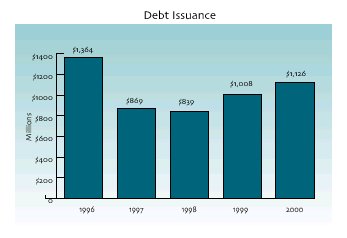
| TRENDS IN LONG-TERM DEBT OBLIGATIONS |
| (MILLIONS OF DOLLARS) |
| CATEGORY |
FY96 |
FY97 |
FY98 |
FY99 |
FY00 |
| Bonds |
8,981 |
9,229 |
9,299 |
9,355 |
9,752 |
| Pension Liabilities |
6,334 |
6,597 |
6,761 |
7,242 |
7,623 |
| Workers' Comp. |
268 |
283 |
279 |
280 |
284 |
| Compensated Absences |
262 |
260 |
264 |
275 |
294 |
| Capital Leases |
54 |
49 |
48 |
52 |
49 |
| TOTAL |
15,899 |
16,418 |
16,651 |
17,204 |
18,002 |
Table
of Contents | Index of Comptroller's
Reports | Comptroller's Home
Page
